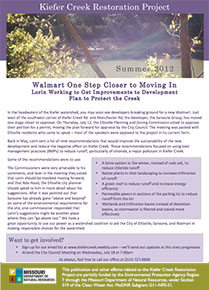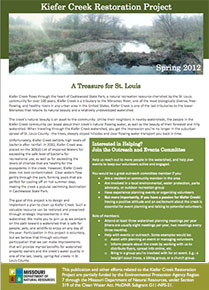Published in April 2014
Building A Better Watershed Together
The success of our efforts hinges on our ability to communicate and work with community members to foster the implementation of infrastructure improvements and ecosystem restoration. There are many stakeholders and stakeholder groups in the Kiefer Creek Watershed, and we are working to engage all of them in the development of our watershed plan.
Watershed Residents
When you take the time to read the street signs in the Kiefer Creek Watershed you will notice that many of them are named after the creek or the natural features of the watershed. The people who live in the area know that they are in a special place. Whenever we meet watershed residents during our monthly hikes or at planning meetings they usually bring up how much the enjoy the natural feel of the watershed. We are working on finding ways to turn the enthusiasm of the residents into meaningful action in the watershed. As we move forward on our project we hope to launch a number of programs to help residents enhance their watershed:
- Foster improvement of home and neighborhood landscaping with native plantings and designed features like rain gardens and bio-swales. Through sustainable plantings residents will be able to reduce lawn maintenance costs, increase habitat for pollinator species like butterflies, and reduce nutrient pollution and flash flooding in Kiefer Creek.
- Work with residents to find ways to improve septic system performance and maintenance.
- Coordinate opportunities to keep horse waste out of the stream channel.
- Educate and encourage the proper management of pet waste.
Watershed Municipalities
The Kiefer Creek Watershed overlays the municipalities of Ballwin, Ellisville, Wildwood, as well as unincorporated St. Louis County. Each community has its own perspective, and will be approached about ways to improve watershed stewardship. Municipal governments play an important role in a watershed in that they regulate zoning and development patters, manage road salt application and public parks, and they set out landscape guidelines for new developments. Through engagement with local municipalities we hope to:
- Reduce chloride impacts in Kiefer Creek by encouraging municipalities to switch to a brine (liquefied salt) system. Although there is the upfront cost of the brine truck(s), many communities have done this and found that the savings from the reduced amount of salt used paid for the truck within a few years.
- Encourage municipalities and the county to require that, upon the time of sale, all properties that are not connected to MSD be inspected for effectiveness of on-site treatment. If an issue is found the cost of the repair, replacement or lateral connection to an available sewer main will be included in the sale price of the home.
- Work with municipalities to develop landscape guidance that fosters native ecosystems while reducing maintenance costs and waters usage.
Kiefer Creek Newsletter



